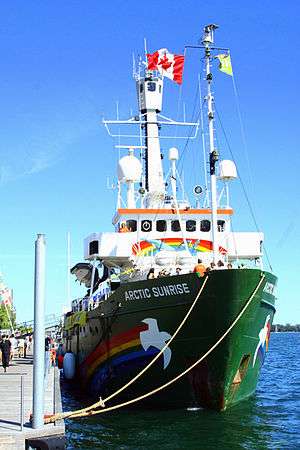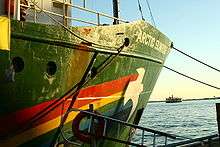MV Arctic Sunrise
Arctic Sunrise is an ice-strengthened vessel operated by Greenpeace. The vessel was built in Norway in 1975 and has a gross tonnage of 949, a length of 50.5 metres (166 ft) and a maximum speed of 13 knots (24 km/h; 15 mph). She is classified by Det Norske Veritas as a "1A1 icebreaker" (the second highest ice strengthening notation at the time of construction).[2][3]
 MV Arctic Sunrise Bow | |
| History | |
|---|---|
| Name: | Polarbjørn |
| Owner: | GC Rieber Shipping |
| Port of registry: | Ålesund |
| Builder: | Vaagen Verft, Kyrksæterøra, Norway |
| Yard number: | 39 |
| Completed: | 18 January 1975 |
| Fate: | Sold in 1995 to Greenpeace |
| Name: | Arctic Sunrise |
| Owner: | Stichting Phoenix |
| Operator: | Stichting Greenpeace Council |
| Port of registry: | Amsterdam |
| Identification: | Call sign: PE6851IMO number: 7382902 |
| Status: | In service |
| General characteristics [1] | |
| Tonnage: | 949 GT353 NT610 DWT |
| Displacement: | 1,478 tonnes |
| Length: | 49.5 m (162 ft) |
| Beam: | 11.55 m (37.9 ft) |
| Draft: | 5.32 m (17.5 ft) |
| Ice class: | DNV Icebreaker (maximum draught 4.7 m) |
| Installed power: | MaK 9M452AK (1,619 kW) |
| Propulsion: | Single shaft; controllable-pitch propellerTwo thrusters (400 hp each) |
| Speed: | 13 knots (24 km/h; 15 mph) |
| Crew: | 16 |
Under the original name of Polarbjørn ("polar bear"), she was used as a sealing ship. The vessel was subsequently used by the French government. Greenpeace purchased the ship in 1995.
Actions

Arctic Sunrise has been involved in various campaigns including anti-whaling campaigns in the Southern Ocean. She is registered as a Motor Yacht (MY).
In January 2006 Arctic Sunrise and Nisshin Maru, a Japanese whaling ship, collided. Both ships suffered minor damage.
In June 2006, Arctic Sunrise was banned from attending the 58th International Whaling Commission meeting in St. Kitts by the St. Kitts and Nevis Government citing national security concerns.[4] Greenpeace's protests were discussed at the same IWC meeting with agenda item IWC/58/3, relating to their protest actions against Japanese whaling in the Southern ocean in December 2005 / January 2006, during which a Japanese whaling ship and a Greenpeace ship collided, resulting in this resolution from the IWC.[5][6]
On 30 August 2007, Arctic Sunrise was involved in a protest against the Canadian laker Algomarine off of Nanticoke, Ontario where she was attempting to enter harbor with a load of coal for the power station. A RHIB came alongside and activists painted the hull of the laker with "No Coal. No Nuclear. Clean Energy." Two activists then boarded Algomarine and chained themselves to the self-unloading boom. A third activist suspended herself with a climbing harness from the rudder of Algomarine, effectively halting it. The Canadian Coast Guard was called in to remove the protesters.
In early February 2007 the ship was moored in Leith docks, in Edinburgh. On 23 February 2007, she took part in a blockade of Faslane Naval Base and was subsequently impounded by the MoD police but after weeks of the ship being impounded and campaigning the vessel was released.
2013 incident
In September 2013, Arctic Sunrise participated in Greenpeace protests against oil drilling activities by the Russian energy company Gazprom at the Prirazlomnaya oil rig in the Pechora Sea. Greenpeace opposes oil drilling in the Arctic on the grounds that oil drilling damages the Arctic ecosystem, and that no safety plans are in place to prevent oil spills. Earlier in August 2012, Greenpeace staged similar protests against the same oil rig.[7] On 18 September, the crew of Arctic Sunrise circled the Prirazlomnaya oil rig, while three crew attempted to board the platform. In response, the Russian Coast Guard seized control of the ship and detained the activists.[8][9][10] The ship was later towed by a coast guard vessel to the Russian Arctic port of Murmansk. The Arctic Sunrise crew consisted of 30 members from 16 nationalities. The Russian government intended to charge the Greenpeace activists with piracy, which carries a maximum penalty of fifteen years of imprisonment,[7] although Russian President Vladimir Putin has said the activists are obviously "not pirates".[11] Putin distanced himself from the case and indicated that the independent Russian judiciary would continue with the investigation. On 23 October 2013 the Russian prosecution altered the charges against the activists, rescinding the piracy allegation and charging them instead with hooliganism. A conviction of hooliganism in Russia can result in costly fines and up to seven years in prison. According to Phil Radford, Executive Director of Greenpeace in the U.S. at the time, the reaction of the Russian coast guard and courts was the "stiffest response that Greenpeace has encountered from a government since the bombing of the Rainbow Warrior in 1985."[12]
The Netherlands asked the International Tribunal for the Law of the Sea to order Russia to release a Greenpeace ship and the activists who were on board.[13] Russia subsequently indicated that it would not participate in the tribunal since the matter was an issue of internal Russian law involving criminal acts against Russian property. Despite the non-appearance, the Tribunal granted provisional measures releasing the entire crew and the ship on a financial bond.[14][15][16]
The ship was boarded by the Russian coast guard and towed 500 miles from the Pechora Sea to the northern Russian port of Murmansk in September 2013. The 30 activists were all released from prison due to an amnesty in celebration of the 20th anniversary of Russia's post-Soviet constitution,[17][18] but the ship remained in Russian port pending a decision by the Russian investigative committee (IC) until June 2014.[19]
Russia was ordered to pay damages on 24 August 2015 to the Netherlands over its seizure.[20] The Permanent Court of Arbitration in The Hague said the amount of damages would be decided at a later date.[20] On 18 July 2017 the International Arbitration Tribunal in The Hague ordered the Russian Federation to pay the Netherlands 5,4 million euros.[21]
See also
- Rainbow Warrior (1955), an older Greenpeace vessel that was sunk by French intelligence service in 1985
- Rainbow Warrior (2011), the third Greenpeace vessel to carry the name
- MV Esperanza, another ship operated by Greenpeace
References
- "Arctic Sunrise (09552)". DNV GL Vessel Register. Det Norske Veritas. Retrieved 24 October 2013.
- "DNV Exchange - ARCTIC SUNRISE - Classification". Det Norske Veritas. Archived from the original on 2 December 2013. Retrieved 19 November 2013.
- "Det Norske Veritas statement". Greenpeace. Retrieved 26 November 2013.
- Sun St. Kitts. St. Kitts/Nevis bars Greenpeace ship. 15 June 2006.
- Resolution 2006-2. RESOLUTION ON THE SAFETY OF VESSELS ENGAGED IN WHALING AND WHALE RESEARCH-RELATED ACTIVITIES Archived 1 November 2010 at the Wayback Machine
Videos of the main incident can be seen here:
Video 1
Video 2 (man speaking on microphone and ship tooting) - Greenpeace (Oceans). 8 January 2006.Whalers ram Greenpeace ship Archived 3 September 2010 at the Wayback Machine.
- Shaun Walker (24 September 2013). "Russia to charge Greenpeace activists with piracy over oil rig protest". The Guardian. Retrieved 25 September 2013.
- "Greenpeace International responds to allegations from Russian authorities". Greenpeace International. 22 September 2013. Retrieved 25 September 2013.
- "Armed Russian guards storm Greenpeace vessel in Arctic". Channel News Asia. 25 September 2013. Archived from the original on 27 September 2013. Retrieved 25 September 2013.
- "Footage of the seizure". The Guardian. 8 November 2013. Retrieved 10 November 2013.
- Amnesty: Piracy charges 'absurd' Archived 29 October 2013 at the Wayback Machine. 3 News NZ. 4 October 2013.
- Lally, Kathy; Englund, Will. "U.S. Greenpeace captain jailed in Russia". The Washington Post. Retrieved 2 October 2013.
- Netherlands asks sea law tribunal to order Russia to release Greenpeace ship and activists, Washington Post, 21 October 2013
- "www.itlos.org: Case No. 22". www.itlos.org.
- Peiris, Nuwan (1 January 2015). "Arctic Sunrise from ITLOS: The Arctic Surprise and in Search of a Balanced Order". Ocean Yearbook Online. 29 (1): 44–60. doi:10.1163/22116001-02901004 – via booksandjournals.brillonline.com.
- Elferink, Alex G. Oude (9 June 2014). "The Arctic Sunrise Incident: A Multi-faceted Law of the Sea Case with a Human Rights Dimension". The International Journal of Marine and Coastal Law. 29 (2): 244–289. doi:10.1163/15718085-12341318. hdl:10037/7178 – via booksandjournals.brillonline.com.
- "Russian amnesty to benefit Pussy Riot, Greenpeace 30". 19 December 2013 – via Reuters.
- "Russia parliament approves amnesty for prisoners". 18 December 2013 – via www.bbc.com.
- Arctic 30: Russia releases Greenpeace ship, Russian authorities have released the Arctic Sunrise, which was involved in a high-profile protest against Arctic oil drilling The Guardian 6 June 2014
- "Arctic Sunrise case: Russia ordered to pay damages". BBC News. 24 August 2015.
- "Tribunal in The Hague fined the Russian Federation for 5.4 million euros for the capture of the Greenpeace ship". FrontNews International. 18 July 2017. Retrieved 8 October 2019.
External links
| Wikimedia Commons has media related to Arctic Sunrise (ship, 1975). |